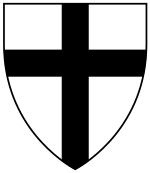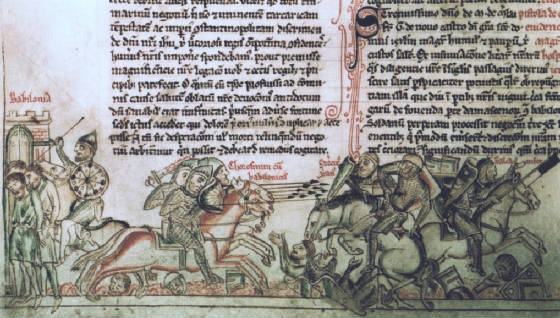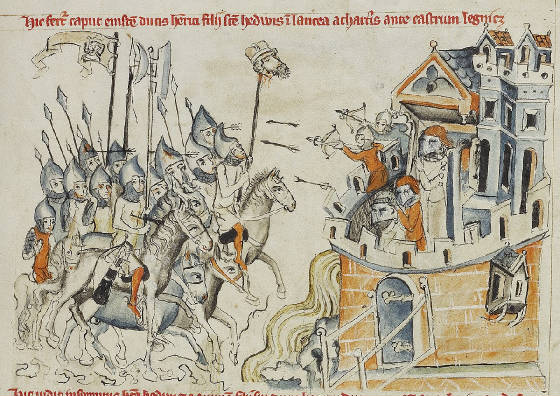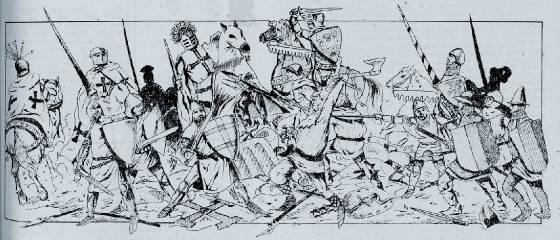


The Battle of Durbe - 1260
The Battle of Durbe (Latvian: Durbes kauja, Lithuanian: Durbės
mūšis, German: Schlacht an der Durbe) was a medieval battle fought near Durbe, 23 km east of Liepāja, in
present-day Latvia during the Livonian Crusade. On 13 July 1260 the Samogitians soundly defeated the joint forces of the Teutonic
Knights from Prussia and Livonian Order from Livonia. 150 knights were killed including Livonian Master Burchard von Hornhausen
and Prussian Land Marshal Henrik Botel. It was by far the largest defeat of the knights in the 13th century: in the second-largest
Battle of Aizkraukle 71 knights were killed. The battle inspired the Great Prussian Uprising (ended in 1274), rebellion of
the Semigallians (surrendered in 1290) and the Couronians (surrendered in 1267). The battle undid some 20 years of Livonian
conquest and it took some thirty years for the Livonian Order to restore its control.

The Livonian Order had been fighting the Samogitians
since 1253, when Mindaugas was crowned as King of Lithuania and transferred parts of Samogitia to the Order. The Samogitians
did not recognize the transfer and fought for their independence. For the Knights, Samogitia was strategically important region
as it physically separated their Prussian and Livonian branches. After the Samogitians killed 12 knights near the newly-built
Memel Castle (Klaipėda) in 1257, a two-year truce was made. Once the truce expired, the Samogitians invaded Courland
and defeated the knights in the Battle of Skuodas in 1259. Such a success encouraged the Semigallians to rebel. The Knights
attempted to strengthen their strategic position and attacked Tērvete (Terwerten) hoping to turn the Semigallian outpost
into a Teutonic castle. When the attack failed, they built a fortress in nearby Dobele (Doblen) and Georgenburg (possibly
present-day Jurbarkas) in Samogitia.

The Semigallians attacked Dobele, but due to poor siege
tactics suffered heavy casualties. The Samogitians did not attack Georgenburg directly but built a fortress nearby, cutting
off the castle from its supplies and continuously harassing the garrison.Livonian Grand Master Burchard von Hornhausen organized
a large army for a campaign against the Samogitians. On 25 January 1260, the Knights obtained a papal bull blessing the crusade
from Pope Alexander IV and peace treaty with Siemowit I of Masovia. When the armies of the Prussian and Livonian Orders and
their allies met in the Memel Castle, they planned to reinforce the besieged Georgenburg. However, they learned that a large
Samogitian force was raiding Courland and the knights decided to march towards present-day Latvia and stop the Samogitians.
The enemies met on the southern shore of the Durbe Lake.

The Knights were plagued by internal
disagreements. For example, Danes from Estonia refused to dismount from their heavy horses which were not well-suited for
battle in a swampy terrain. When the battle started, local Curonians abandoned the knights because the knights did not agree
to free any Curonians captured from the Samogitian camp. Peter von Dusburg even alleged that the Curonians even attacked the
Knights from the rear. The Estonians and other local people soon followed the Curonians and abandoned the Knights. After this
treason the Knights were surrounded and suffered heavy losses. Some 150 knights perished along with hundreds of secular knights
or low-rank soldiers. Though the battle is described in the
Livonian Rhymed Chronicle in detail, no contemporary sources mentioned who was the leader of the Samogitians. Only Simon Grunau,
in his chronicle written ca. 1517-1526, mentioned that it was Treniota. In 1982 historian Edvardas Gudavičius published
a study arguing that Treniota was not a Samogitian and could not have commanded a Samogitian army.

Inga Baranauskienė argued that the battle
was led by Alminas, Samogitian elder elected before 1256. Numerous rebellions against the Teutonic Order across all Baltic
lands followed, including the Great Prussian Uprising, which lasted from 1260 to 1274. Zemgale rebelled for 30 years while
Courland surrendered in 1267. The Curonians together with the Samogitians attacked Teutonic castles west of Venta River. On
3 February 1261, on their way back the pagans again defeated the Knights near Lielvārde (Lennenwarden), killing 10 knights.
These battles undid some 20 years of Livonian conquest and it took some thirty years for the Livonian Order to restore its
control. In the aftermath of the defeat, Duke Treniota is alleged to have convinced his uncle Mindaugas, King of Lithuania,
to relapse from Christianity and break the peace with the Teutonic Order. Treniota organized military campaigns into Livonia
and earned support from the Lithuanians. In 1263 Treniota assassinated Mindaugas, usurped the Lithuanian throne and the nation
reverted back to paganism. Ensuing instability prevented the Grand Duchy of Lithuania from taking full advantage of the weakened
Orders. However, the Orders were preoccupied conquering back rebelling territories and did not pose a greater danger to Lithuania
until 1280s. In this sense the battle bought time for the new Lithuanian state to mature, strengthen, and expand before facing
full-scale crusade.
